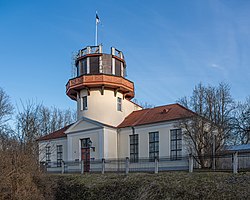Struve Geodetic Arc
The Struve Geodetic Arc is a chain of survey triangulations that go from Hammerfest in Norway to the Black Sea. They go through ten countries and over 2,820 kilometres (1,750 miles). It made the first accurate measurement of a meridian arc.
| Struve Geodetic Arc | |
|---|---|
 | |
Map of the Struve Geodetic Arc where red points identify the World Heritage Sites. | |
| General information | |
| Type | Ensemble of memorable sites |
| Location | Estonia, Belarus, Finland, Latvia, Lithuania, Norway, Moldova, Russia, Sweden, and Ukraine |
| Coordinates | 59°3′28″N 26°20′16″E / 59.05778°N 26.33778°ECoordinates: 59°3′28″N 26°20′16″E / 59.05778°N 26.33778°E |
| Design and construction | |
| Architect | Friedrich Georg Wilhelm von Struve |
| Official name | Struve Geodetic Arc |
| Criteria | ii, iii, vi |
| Reference | 1187 |
| Inscription | 2005 (29th Session) |
The chain was made and used by the German-born Russian scientist Friedrich Georg Wilhelm von Struve in the years 1816 to 1855. He did this to find the exact size and shape of the earth. At that time, the chain passed through two countries: Union of Sweden-Norway and the Russian Empire. The Arc's first point is in Tartu Observatory. This is where Struve did much of his research.
In 2005, the chain was added on the World Heritage List. There are 34 plaques or obelisks out of the original 265.
Chain
Norway
- Fuglenes in Hammerfest
- Raipas in Alta
- Luvdiidcohkka in Kautokeino
- Baelljasvarri in Kautokeino
Sweden
- "Pajtas-vaara" (Tynnyrilaki) in Kiruna
- "Kerrojupukka" (Jupukka) in Pajala
- Pullinki in Övertorneå
- "Perra-vaara" (Perävaara) in Haparanda
Finland
- Stuor-Oivi (currently Stuorrahanoaivi) in Enontekiö (68°40′57″N 22°44′45″E / 68.68250°N 22.74583°E)
- Avasaksa (currently Aavasaksa) in Ylitornio (66°23′52″N 23°43′31″E / 66.39778°N 23.72528°E)
- Torneå (currently Alatornion kirkko) in Tornio (65°49′48″N 24°09′26″E / 65.83000°N 24.15722°E)
- Puolakka (currently Oravivuori) in Korpilahti (61°55′36″N 25°32′01″E / 61.92667°N 25.53361°E)
- Porlom II (currently Tornikallio) in Lapinjärvi (60°42′17″N 26°00′12″E / 60.70472°N 26.00333°E)
- Svartvira (currently Mustaviiri) in Pyhtää (60°16′35″N 26°36′12″E / 60.27639°N 26.60333°E)
Russia
- "Mäki-päälys" (Mäkipäällys (Finland 1917/1920-1940) in Hogland (Suursaari)
- "Hogland, Z" (Gogland, Tochka Z) in Hogland (60°5′9.8″N 26°57′37.5″E / 60.086056°N 26.960417°E)
Estonia
- "Woibifer" (Võivere) in Väike-Maarja Parish (59°03′28″N 26°20′16″E / 59.05778°N 26.33778°E)
- "Katko" (Simuna) in Väike-Maarja Parish (59°02′54″N 26°24′51″E / 59.04833°N 26.41417°E)
- "Dorpat" (Tartu Observatory) in Tartu. (58°22′43.64″N 26°43′12.61″E / 58.3787889°N 26.7201694°E)
Latvia
- "Sestu-Kalns" (Ziestu) in Ērgļu novads (56°50′24″N 25°38′12″E / 56.84000°N 25.63667°E)
- "Jacobstadt" in Jēkabpils (56°30′05″N 25°51′24″E / 56.50139°N 25.85667°E)
Lithuania
- "Karischki" (Gireišiai) in Panemunėlis (55°54′09″N 25°26′12″E / 55.90250°N 25.43667°E)
- "Meschkanzi" (Meškonys) in Nemenčinė (54°55′51″N 25°19′00″E / 54.93083°N 25.31667°E)
- "Beresnäki" (Paliepiukai) in Nemėžis (54°38′04″N 25°25′45″E / 54.63444°N 25.42917°E)
Belarus
- "Tupischki" (Tupishki) in Oshmyany district (54°17′30″N 26°2′43″E / 54.29167°N 26.04528°E)
- "Lopati" (Lopaty) in Zelva district (53°33′38″N 24°52′11″E / 53.56056°N 24.86972°E)
- "Ossownitza" (Ossovnitsa) in Ivanovo district (52°17′22″N 25°38′58″E / 52.28944°N 25.64944°E)
- "Tchekutsk" (Chekutsk) in Ivanovo district (52°12′28″N 25°33′23″E / 52.20778°N 25.55639°E)
- "Leskowitschi" (Leskovichi) in Ivanovo district (52°9′39″N 25°34′17″E / 52.16083°N 25.57139°E)
Moldova
- "Rudi" near Rudi village, Soroca district (48°19′08″N 27°52′36″E / 48.31889°N 27.87667°E)
Ukraine
- Katerinowka in Antonivka, Khmelnytsky Oblast (49°33′57″N 26°45′22″E / 49.56583°N 26.75611°E )
- Felschtin in Hvardiiske, Khmelnytsky Oblast (49°19′48″N 26°40′55″E / 49.33000°N 26.68194°E )
- Baranowka in Baranivka, Khmelnytsky Oblast (49°08′55″N 26°59′30″E / 49.14861°N 26.99167°E )
- Staro-Nekrassowka (Stara Nekrasivka) in Nekrasivka, Odesa Oblast (45°19′54″N 28°55′41″E / 45.33167°N 28.92806°E )
Struve Geodetic Arc Media
Other websites
![]() Media related to Struve Geodetic Arc at Wikimedia Commons
Media related to Struve Geodetic Arc at Wikimedia Commons
![]()






